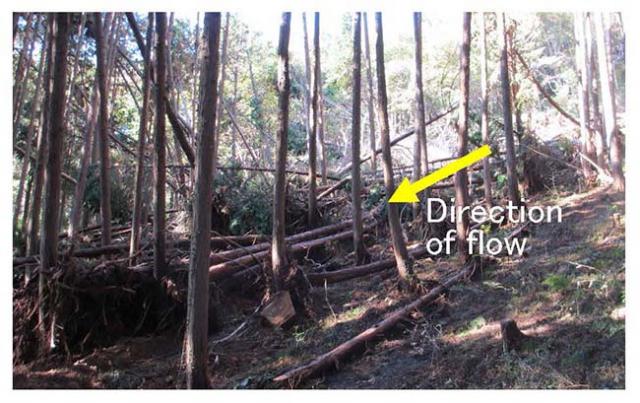Home > Research > Research Results > Research Results 2019 > Onsite demonstration of the efficacy of Japanese cedar trees in stopping drifting wood and debris during a landslide
Update:September 11, 2019
Main content starts here.
Onsite demonstration of the efficacy of Japanese cedar trees in stopping drifting wood and debris during a landslide
| Article title |
Measuring the critical turning moment of the Japanese cedar (Cryptomeria japonica) in situ |
|---|---|
| Author (affiliation) |
Yasuhiko Okada (a) (a) Department of Disaster Prevention, Meteorology and Hydrology, FFPRI, Tsukuba, Ibaraki, Japan. |
| Publication Journal |
Journal of Forest Research、24(3):168-177, June 2019 DOI:10.1080/13416979.2019.1617098( External link ) |
| Content introduction |
In Japan, local heavy rain referred to as “guerrilla rain” is no longer a rare event. These rains may cause landslides, resulting in devastation at the base of mountains, which is a major concern. Some construction projects, such as building a dam on the slope for reinforcement, have been implemented to reduce landslide damage. These dams however have a limited effect. Therefore, it is important to maximise the performance of disaster-preventative function of the existing natural forests. The presence of trees on mountain slopes prevents landslides because of the anchoring effect of the roots that spread underground. The standing trees also capture drifting wood and debris in the event of a landslide. However, if the momentum of the flowing objects is larger than the resistance provided by the standing trees, the trees will fall and be carried away. Therefore, it is important to know the limitation. In this study, we performed tree-pulling experiments with Japanese cedar trees on a slope and derived a mathematical formula that shows the resistance exhibited during such events. The resistance provided by Japanese cedar trees rapidly increased as their diameter increased. For example, a tree with a diameter of 35 cm at breast height was found to have an expected resistance of 139.6 kNm*. This value is 1.6 times higher than the estimated resistance from a previously used evaluation formula. The information thus obtained is useful in physical experiments using a flume or a numerical simulation reproducing and verifying actions of standing trees on drifting wood and debris. *This is equivalent to lifting an approximately 14-ton weight loaded onto a seesaw, 1 m from the fulcrum (considering that the weight of the seesaw can be neglected).
Photograph: Standing trees stopping the drifting wood and debris (the photograph taken from the right-side bottom area). |
Copyright © Forest Research and Management Organization. All rights reserved.

